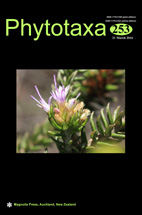Abstract
Cryptantha pterocarya (Boraginaceae), the winged nut popcorn flower, is distinguished in part by nutlets with marginal, typically lobed wings. Four varieties of this species have been accepted in recent treatments: vars. cycloptera, pterocarya, purpusii, and stenoloba. We tested the taxonomic discreteness, degree of variation, and geographic range of these varieties of C. pterocarya by examining material from numerous voucher specimens. We quantified differences among specimens by measuring or calculating twenty features of the corolla and fruit, the latter focusing on mature (fruiting) calyx and nutlet characteristics. Type specimens of all four varieties were examined and quantified, and all specimens were georeferenced and mapped. From our observations and measurements, we recognize two new morphological forms in the complex, termed the “pseudocycloptera” form and the “truncata” form. The “pseudocycloptera” form is similar to var. pterocarya but is homomorphic, with all four nutlets winged. The “truncata” form is similar to var. cycloptera, but is heteromorphic, with the odd nutlet having a reduced basal wing (somewhat truncate in shape) and having a slightly reduced gynobase stipe. We conclude that C. p. var. pterocarya, var. purpusii, and var. stenoloba should continue to be recognized as taxa at that rank. The “pseudocycloptera” form, although generally morphologically discrete in nutlet heteromophism, shows some intergradation, even within a specimen, of the typical form of C. p. var. pterocarya and exhibits no clear geographic discontinuity; it should thus be recognized as a homomorphic form of that taxon, which we formally name forma pseudocycloptera. Variety purpusii should continue to be recognized at that rank given its variation in nutlet wing morphology but with continuity in geographic range. Variety stenoloba should also continue to be recognized at this rank given its distinctive calyx and nutlet body size and shape, but having a quite limited geographic range. We conclude that what has been most commonly recognized as C. pterocarya var. cycloptera should be resurrected to the rank of species, as C. cycloptera, because of the distinctiveness of this taxon in three, discrete morphological characters, one of which (gynobase stipe) was previously undescribed. The “truncata” form, which shows some intergradation with C. cycloptera and lacks geographic discontinuity, should be recognized as a heteromorphic form of C. cycloptera, which we formally name forma truncata. A revised key is proposed to better accommodate the identity of these taxa and forms. We hope that future molecular studies will elucidate the phylogenetic relationships, character evolution, and geographic history of this interesting taxonomic complex.

